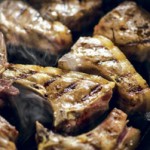Grass-fed Lamb: Not Baaaad
Besides being a former Kaua’i County Councilmember, Daryl W. Kaneshiro is building a housing development, solar plant, aquaponic farm and has about 400 ewes (female sheep) that he raises on 300 acres. His lambs are grass-fed and antibiotic-free.
Over the next three years, Kaneshiro plans to grow the herd to 1,000 sheep. Rams are sold whole to local restaurants, and live to local families. His oldest son Arryl is taking over the ranch while his youngest son Kye tends a vegetable garden.
LAMB
Sheep are docile herd mammals that eat a plant-based diet. Forage on pasture and hay is the most natural diet for these ruminant animals. Although they will eat grain, ruminants are less likely to experience digestive problems (acidosis and kidney disease) when eating their natural diet. Scientists at the University of Cambridge discovered that sheep have brainpower to equal rodents, monkeys and, in some tests, humans. The sheep showed that they had advanced learning capabilities, as they were able to navigate the challenges in the same way as humans and primates. Australian researchers say that sick sheep seek out plants that make them feel better.
Sheep are the most numerous livestock in the world, and lamb or mutton (the flesh of mature sheep) is the principal meat in parts of Europe, North Africa, the Middle East and India.
Season: Sheep are seasonal breeders, but on Kaua’i they are able to breed year-round. Gestation period is about five months, and normal labor takes one to three hours. Most produce single or twin lambs.
What to look for: Prepackaged lamb sold in grocery stores is ordinarily dated for freshness. Other signs of freshness are firm, pinkish-red meat (lamb darkens with age), bones that are reddish and moist at the joint, and fat that is creamy white.
Storage: Make sure the lamb is securely wrapped, and store in the coldest part of the refrigerator. Whole roasts will keep up to five days, chops and steaks for up to four, and ground or cubed meat will keep up to two days.
Preparation: Dishes featuring lamb range from roasted whole leg of lamb seasoned with assertive herbs – a specialty in Italy and Southern France – to Greek moussaka (a ground-lamb dish) to savory kebabs, curries and stews prepared in Iraq, India and Ireland.
Breast of lamb is roasted or braised; leg of lamb is the most popular cut and is usually roasted whole. The loin is considered the choicest part of the lamb and makes an excellent roast; roasting a whole rib, known as rack of lamb, makes an elegant dinner presentation. Rib chops are tender and are best grilled; the shoulder is the toughest part and is best braised or stewed. Ground lamb is used in traditional shepherd’s pie, or formed into burgers.
Lamb pairs well with cinnamon, mint, rosemary, bay leaves, sage, thyme, citrus, garlic, and curry powder.
Health benefits: A recent Consumer Reports article called “Meat on Drugs” found that 86 percent of Americans want meat raised without antibiotics available in their supermarkets. And there’s good reason: The animals we eat consume more antibiotics than we do, making us susceptible to superbugs. The increasing prevalence of antibiotic-resistant bacterial infections seen in clinical practice stems from antibiotic use both within human and veterinary medicine. Antibiotic resistance is a type of drug resistance, and it poses a significant problem.
Lamb from Oma’o Ranch Lands can be found at: Restaurants: Oasis on the Beach, Grown, and Mark’s Place. For live lambs, call 651-6906.
GRILLED LAMB CHOPS
This is a simple recipe I learned from my mother, who serves it with alioli, a Spanish spread made with olive oil, eggs and garlic. The tender chops are small, so you want to have three or four per serving.
* 6 lamb chops
* 1/2 teaspoon each salt and freshly ground black pepper
Allow the lamb chops to come to room temperature by taking them out of the refrigerator 30 minutes before you plan to cook them. Get your grill, or grill pan, nice and hot. Sprinkle both sides of the lamb with salt and pepper. Lamb is fatty, so you don’t need any cooking oil. Place the chops in a dry pan, and cook two minutes per side. Allow chops to rest for five minutes. Serve with roasted carrots tossed in butter and thyme, and sautéed green beans.
Makes two servings.
- (from left: Kye and Daryl Kaneshiro, Britni Ludington and Corey Rosare
- Grilled lamb chops
- Oma‘o Ranch is on 300 acres
- Sheep are docile herd animals. Dan Lane photos
- Foraging on pasture is the natural diet for sheep. Dan Lane photo








